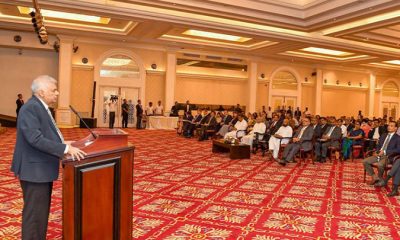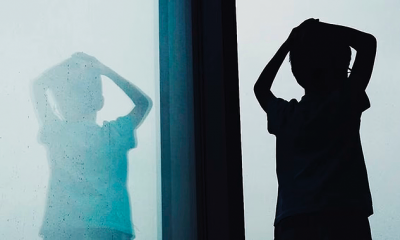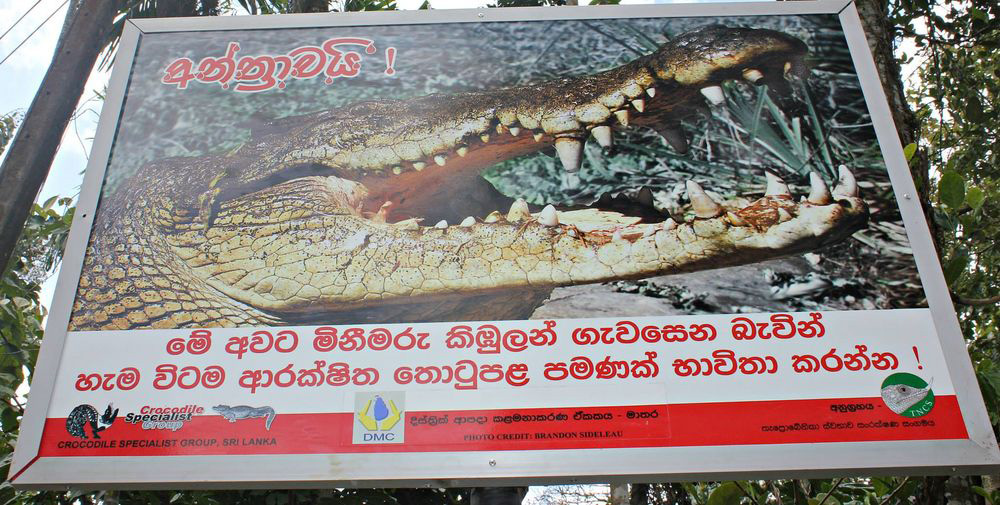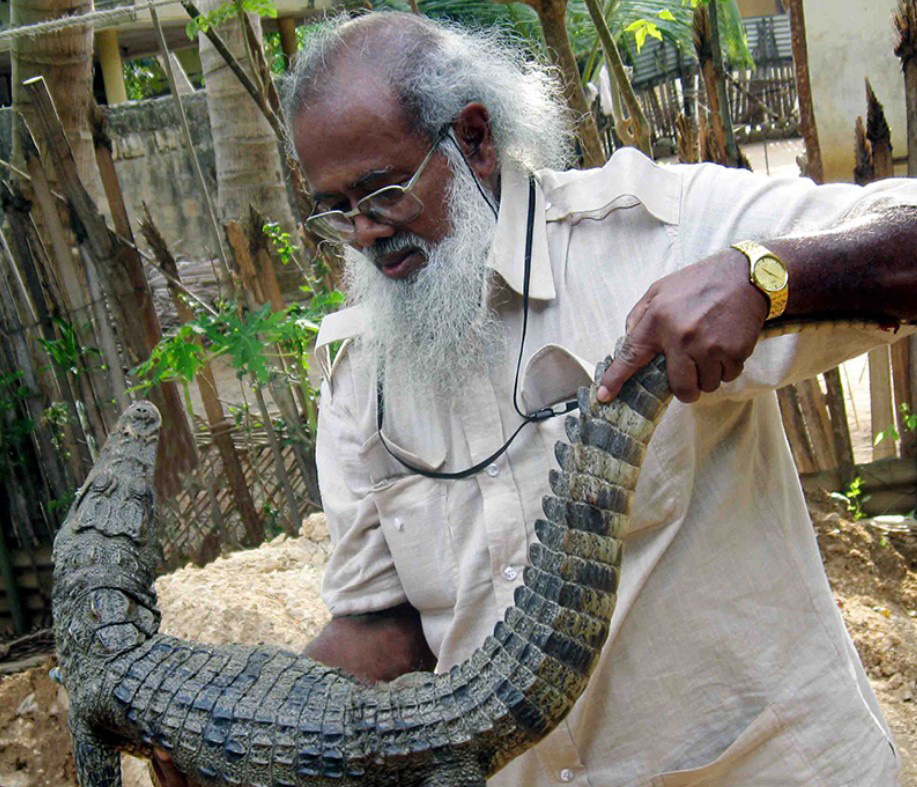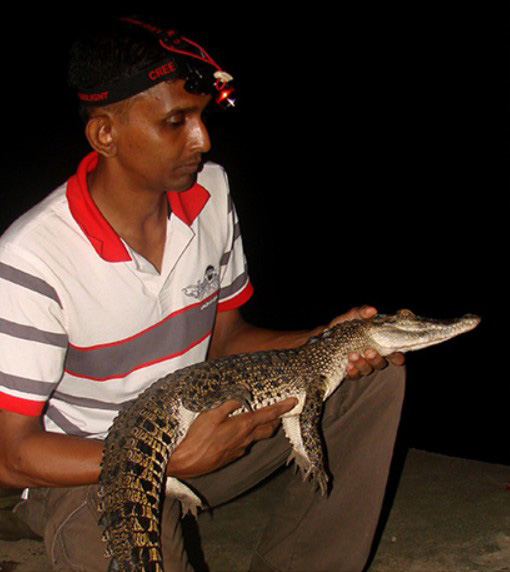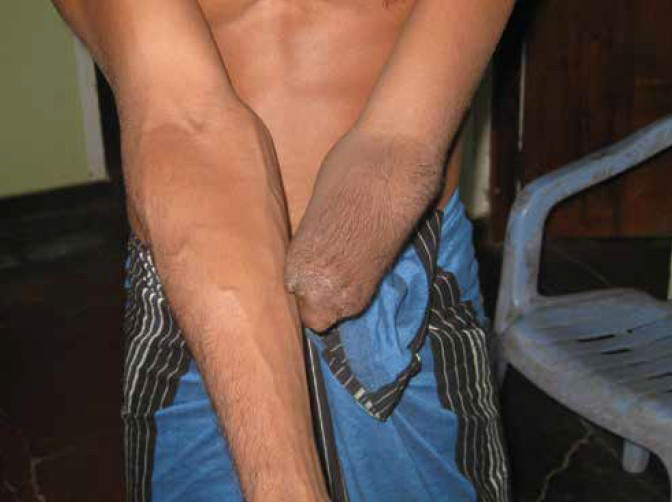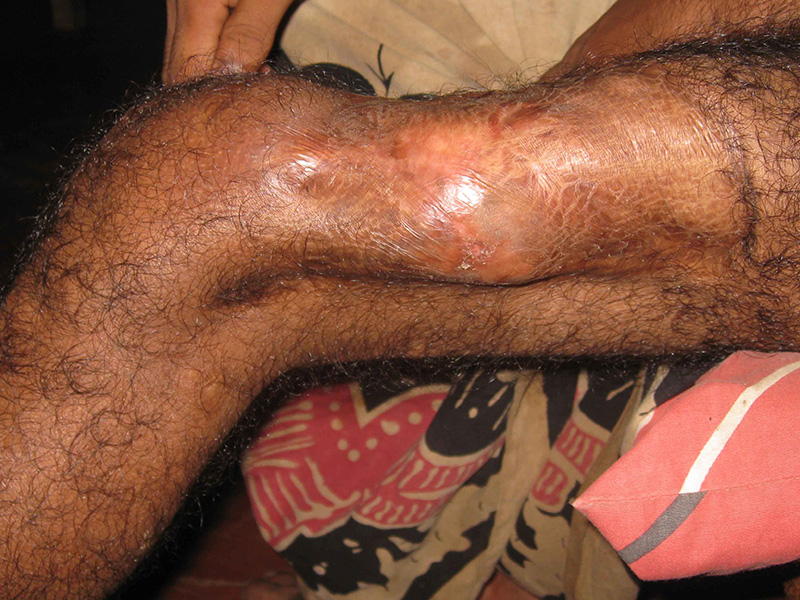Features
Challenges faced by Arts and Humanities Graduates in University System of Sri Lanka

By M. W. Amarasiri de Silva.
(Emeritus Professor, University of Peradeniya and Adjunct Professor,
University of Pittsburgh, and Lecturer, UCSC, USA)
In the university system of Sri Lanka, the Arts and Humanities faculties have a significant presence, comprising the largest student population, surpassing 25% of the total annual intake. However, despite their substantial representation, Arts and Humanities graduates encounter substantial challenges in terms of employability. A staggering 75% of these graduates find themselves unemployed immediately after completing their education. This issue has led to the formation of trade unions specifically catering to the concerns of unemployed Arts and Humanities graduates, which have attracted a sizeable membership.
Arts and Humanities faculties within the Sri Lankan university system have emerged as the largest academic disciplines in terms of student enrolment. This dominance can be attributed to various factors, including historical significance, cultural values, and personal preferences among students.
In the school system, students who sit the GCE A/L examination and those who qualify for university entrance are largely arts and humanities students and mainly female students. The large number of arts and humanities students are coming from rural areas as most rural schools lack facilities for science education.
The arts and humanities graduates are considered not fit for employment in the private sector which value English language and IT skills for employment. The mismatch between the skills acquired during their education and the demands of the job market contributes to this issue. Many Arts and Humanities programmes tend to focus on theoretical and conceptual knowledge, often lacking practical skills and vocational training.
The downfall of the arts and humanities faculties reflects the downfall of the university system. Insufficient funding has been a factor throughout the decades that hindered development of the university system. Minimal facilities for the students, and teaching staff is due to the restrictions on funding provided for the universities. Currently, only 1.9 % of GDP is allocated to higher education in Sri Lanka (World Bank), whereas in India it is.2.9% in 2023. The % of GDP expenditure on education in the world was 14% in 2017 and 12.6% in 2020 (UNESCO Institute for Statistics).
Sri Lanka has tied itself to the United Nations 2030 agenda for SD with the 17 SDGs. The fourth goal of SDGs, “Quality Education” aims to impart inclusive high-quality education and lifelong learning opportunities for all by the year 2030. The vision of the Ministry of higher Education is Sri Lanka to be an international Centre of Excellence on Higher Education, with 10 laudable objectives including increasing student intake, making employable graduates.
The world ranking of Sri Lankan universities has deplorably declined. World university ranking of the Colombo University is 2172 and University of Peradeniya is 2249 (Website Department of Education). The world ranking of universities is typically done through a complex process that involves the evaluation of various factors and criteria. One of the most well-known university rankings is the QS World University Rankings, which provides insights into the performance of universities globally.
Generally, ranking organisations gather a wide range of data from universities. This data can include information about academic reputation, faculty qualifications, research output, student-to-faculty ratio, international diversity, citations per faculty, employer reputation, teaching quality, and more. Research output takes a prominent place. The quantity and impact of research publications are assessed. Metrics like citations per faculty member or per paper are used to measure the influence of a university’s research.
Some rankings consider a university’s ability to transfer knowledge and technology to the commercial sector through patents, licenses, and spin-off companies. Once data is collected, a weighted scoring system is often applied to assign numerical values to each criterion. The universities are then ranked based on their total scores. The number of international students and faculty, as well as collaborations with international institutions, are assessed to determine the global reach and impact of a university.
Suggestions to Improve Higher education in Sri Lanka
1.Vice chancellors in the universities should be appointed based on their administrative skills and other qualifications, and the application should be open to all. The system of selecting VCs from within the universities should be withheld. This way, qualified people can be attracted to hold VC positions, which is imperative for running the universities.
2.The transformation and evolution of higher education have become crucial in a globalised world, where universities need to adapt to emerging trends and demands, which are seen as essentials for economic development. One key strategy to foster academic growth and internationalisation is by granting universities greater independence. This can facilitate the forging of global connections, programme linkages with foreign institutions, and the removal of legal barriers to foreign collaboration. Universities should be made independent so that they can forge connections, link programmes with foreign universities. The legal barriers to such collaboration should be avoided.
3.Legal barriers often act as impediments to international collaborations for universities in Sri Lanka. By removing or minimising these barriers, universities can more effectively participate in collaborative research endeavours, facilitate faculty exchanges, and promote student mobility programmes with their foreign counterparts.
Over-reliance on government funding can curtail a university’s potential, underscoring the necessity of diversifying income streams. By securing a portion of their revenue from research grants, universities can channel resources into pioneering research, infrastructure development, and academic initiatives, fostering growth and spurring innovation.
Introducing incentives for professors who successfully secure research grants serve to enhance motivation and stimulate scholarly pursuits. In cases where a professor secures a research grant, a corresponding percentage of the grant should be added to their salary as a motivating factor. Notably, numerous universities in the USA have witnessed professors boosting their salaries by up to 40% through the acquisition of research grants. A percentage of the grant could be integrated into a professor’s salary, acknowledging their role in advancing knowledge and nurturing a research-driven culture.
4.Faculty Recruitment should be transparent. Many Sri Lankan Universities prefer to hire their own graduates, which is not nice. Open applications for faculty positions ensure that the university attracts the most qualified and diverse candidates, both internally and externally. This practice enhances academic rigor and brings fresh perspectives to the institution. Faculty positions should be filled after calling for open applications, so that qualified people outside the university community can apply for the positions.
This way more qualified academics can be attracted. Foreign nationals should also be allowed to apply for academic positions in the universities. Also, foreign scholars of repute should be given sabbatical positions in the departments to teach courses and do research.
5.The faculty promotion scheme’s point system requires a revision to prioritise research and publications better. Although the current promotion criteria commendably assign higher scores for faculty-published books, there exists a notable absence of a robust monitoring and evaluation mechanism. Instances abound where applicants hastily produce a book, printing a limited quantity—around 25 copies, for example—solely to secure 15 points for promotion consideration.
Such individually generated works often bypass evaluation committees composed of subject matter experts in the respective field. To address this, I propose the establishment of discipline-specific committees consisting of seasoned faculty members within the corresponding subject areas. Their role would involve reviewing book proposals before publication, ensuring that only approved proposals proceed to the publishing phase. Furthermore, the university grants commission should allocate research and book publishing grants to faculty members to facilitate the creation of textbooks and research publications in book format.
6.The prevailing trend within the university system is to allocate less time for senior faculty towards teaching, in contrast to junior faculty members who handle a significant teaching workload across multiple courses. These junior faculty members function as teachers and tutors, dedicating approximately 5-7 hours daily to these tasks. However, this system is flawed in several respects. To begin with, the senior staff members, who possess a greater depth of knowledge and experience, should ideally be better equipped to deliver courses of higher quality than their junior counterparts.
Secondly, the current teaching approach displays a marked imbalance, disproportionately favouring the junior faculty. This disparity ought to be rectified. There should be a move towards a more equitable distribution of the teaching workload, ensuring fairness among faculty members.
7.University housing facilities should be improved / set up for foreign nationals to stay, as they bring foreign exchange. Many universities in Europe and the USA have study programs in identified developing countries, as they feel that the students in such universities should get foreign exposure in developing country settings. The program should be given a prominent place in the university system with hostel and housing facilities for foreign nationals. These programs foster cross-cultural understanding.
When I was the head of sociology, a Danish university wanted to send their anthropology/sociology students comprising 30 persons for one semester to get fieldwork exposure in the war-torn areas of Sri Lanka. They were prepared to pay a tuition of $1500 a month per student.
Once the contract is signed, they agreed to send batches of students for training in fieldwork every year. This facility if it happened would have provided $45,000 or Sri Lanka rupees 14,482,350 every year. One of the important requirements was good hostel facilities with air conditioning and good bathroom facilities. As Peradeniya did not have those facilities, we lost that opportunity.
8.Introducing a community studies program, specifically within the sociology and anthropology programs at universities in Sri Lanka, entails engaging arts and humanities students in an exploration of the challenges faced by rural communities. This initiative involves a participatory approach that actively involves the communities themselves. By doing so, the program can leverage the distinct perspectives and innovative solutions the village residents possess concerning their issues. In the United States, universities have established enduring Community Studies programmes within their arts and humanities departments.
These programes adopt a social justice perspective and concentrate on addressing societal problems by integrating classroom learning and extensive field studies. Enrolled students collaborate closely with both non-governmental and governmental organisations, actively contributing to resolving community-centric issues.
Consequently, these initiatives have effectively addressed the identified challenges and generated employment avenues for graduates in social sciences. By embracing a similar strategy in Sri Lanka, the proposed community studies programme has the potential to cultivate a more comprehensive and solution-driven approach to prevailing societal predicaments. This approach would prove advantageous for the students and the communities they engage with, promoting mutual growth and development.
9.Introduction of a Programme to Engage High School Students in GCE A/L Classes with Hands-On University Experience: In an endeavour to foster a stronger connection between high school students enrolled in GCE A/L classes and the university environment, a pioneering initiative need to be introduced. Drawing inspiration from the acclaimed Science Internship Program (SIP) at UCSC in the USA, this endeavour aims to not only entice students but also bridge the educational representation gap within society.
The SIP, a dynamic science internship programme, serves as a model for attracting students from less represented segments of society to pursue higher education. This program extends an invitation to high school students, encouraging them to partake in a comprehensive 10-week programme facilitated by esteemed professors and subject specialists. The core focus lies in imparting research skills, ultimately guiding participants to undertake research projects.
These research projects, nurtured under the guidance of seasoned experts, culminate in a noteworthy conference presentation. Impressively, some students seize this opportunity to showcase their talents, yielding exceptional projects that have the potential to result in publishable papers. These papers often find their way into student journals or esteemed academic publications.
This initiative is not solely about nurturing academic growth; it’s about nurturing the spark of curiosity and igniting the flame of interest in university-level education and research. By immersing themselves in a hands-on university experience, these high school students not only gain a taste of the academic realm but also cultivate a genuine interest in furthering their education within a university setting.
This innovative programme envisions a future where the minds of school students are captivated by the allure of university education and the world of research. Through internships that stimulate their academic potential, these students gradually develop a profound inclination to pursue higher education and contribute to the realms of research and academia. The UGC ought to earmark funds for a SIP or STEM + Arts and Humanities programme with comparable characteristics, encompassing all universities in Sri Lanka, to rekindle the widespread enthusiasm for university education.
10. It is a widely recognised reality that students hailing from rural areas often encounter educational setbacks. The disparity in educational opportunities between rural and urban regions can be largely attributed to the absence of high-quality schools and competent teachers in rural locales. There exists a prevailing inclination among teachers to seek employment in urban settings. Addressing this issue necessitates a multifaceted approach, encompassing both the enhancement of rural schools and the comprehensive training of educators through teacher’s colleges strategically established in rural areas.
Furthermore, alongside these endeavours, it is imperative to identify promising students from rural backgrounds and offer them support by enrolling them in well-established schools. This support could be extended through a bursary programme akin to the Mahapola programme, which caters to the needs of rural students. This multifaceted approach is instrumental in not only narrowing the educational gap between rural and urban areas but also providing deserving students with the opportunities they rightfully deserve.I trust that both the Minister of Higher Education and the Minister of Education (schools) will attentively consider the recommendations presented in this article.
Features
When floods strike: How nations keep food on the table

Insights from global adaptation strategies
Sri Lanka has been heavily affected by floods, and extreme flooding is rapidly becoming one of the most disruptive climate hazards worldwide. The consequences extend far beyond damaged infrastructure and displaced communities. The food systems and supply networks are among the hardest hit. Floods disrupt food systems through multiple pathways. Croplands are submerged, livestock are lost, and soils become degraded due to erosion or sediment deposition. Infrastructural facilities like roads, bridges, retail shops, storage warehouses, and sales centres are damaged or rendered inaccessible. Without functioning food supply networks, even unaffected food-producing regions struggle to continue daily lives in such disasters. Poor households, particularly those dependent on farming or informal rural economies, face sharp food price increases and income loss, increasing vulnerability and food insecurity.
Many countries now recognie that traditional emergency responses alone are no longer enough. Instead, they are adopting a combination of short-term stabilisation measures and long-term strategies to strengthen food supply chains against recurrent floods. The most common immediate response is the provision of emergency food and cash assistance. Governments, the World Food Programme, and other humanitarian organisations often deliver food, ready-to-eat rations, livestock feed, and livelihood support to affected communities.
Alongside these immediate measures, some nations are implementing long-term strategic actions. These include technology- and data-driven approaches to improve flood preparedness. Early warning systems, using satellite data, hydrological models, and advanced weather forecasting, allow farmers and supply chain operators to prepare for potential disruptions. Digital platforms provide market intelligence, logistics updates, and risk notifications to producers, wholesalers, and transporters. This article highlights examples of such strategies from countries that experience frequent flooding.
China: Grain Reserves and Strategic Preparedness
China maintains a large strategic grain reserve system for rice, wheat, and maize; managed by NFSRA-National Food and Strategic Reserves Administration and Sinograin (China Grain Reserves Corporation (Sinograin Group), funded by the Chinese government, that underpins national food security and enables macro-control of markets during supply shocks. Moreover, improvements in supply chain digitization and hydrological monitoring, the country has strengthened its ability to maintain stable food availability during extreme weather events.
Bangladesh: Turning Vulnerability into Resilience
In recent years, Bangladesh has stood out as one of the world’s most flood-exposed countries, yet it has successfully turned vulnerability into adaptive resilience. Floating agriculture, flood-tolerant rice varieties, and community-run grain reserves now help stabilise food supplies when farmland is submerged. Investments in early-warning systems and river-basin management have further reduced crop losses and protected rural livelihoods.
Netherlands, Japan: High-Tech Models of Flood Resilience
The Netherlands offers a highly technical model. After catastrophic flooding in 1953, the country completely redesigned its water governance approach. Farmland is protected behind sea barriers, rivers are carefully controlled, and land-use zoning is adaptive. Vertical farming and climate-controlled greenhouses ensure year-round food production, even during extreme events. Japan provides another example of diversified flood resilience. Following repeated typhoon-induced floods, the country shifted toward protected agriculture, insurance-backed farming, and automated logistics systems. Cold storage networks and digital supply tracking ensure that food continues to reach consumers, even when roads are cut off. While these strategies require significant capital and investment, their gradual implementation provides substantial long-term benefits.
Pakistan, Thailand, Indonesia, and Vietnam: Reform in Response to Recurrent Floods
In contrast, Pakistan and Thailand illustrate both the consequences of climate vulnerability and the benefits of proactive reform. The 2022 floods in Pakistan submerged about one-third of the country, destroying crops and disrupting trade networks. In response, the country has placed greater emphasis on climate-resilient farming, water governance reforms, and satellite-based crop monitoring. Pakistan as well as India is promoting crop diversification and adjusting planting schedules to help farmers avoid the peak monsoon flood periods.
Thailand has invested in flood zoning and improved farm infrastructure that keep markets supplied even during severe flooding. Meanwhile, Indonesia and Vietnam are actively advancing flood-adapted land-use planning and climate-resilient agriculture. For instance, In Vietnam’s Mekong Delta, pilot projects integrate flood-risk mapping, adaptive cropping strategies, and ecosystem-based approaches to reduce vulnerability in agricultural and distribution areas. In Indonesia, government-supported initiatives and regional projects are strengthening flood-risk-informed spatial planning, adaptive farming practices, and community-based water management to improve resilience in flood-prone regions. (See Figure 1)
 The Global Lesson: Resilience Requires Early Investment
The Global Lesson: Resilience Requires Early Investment
The global evidence is clear: countries that invest early in climate-adaptive agriculture and resilient logistics are better able to feed their populations, even during extreme floods. Building a resilient future depends not only on how we grow food but also on how we protect, store, and transport it. Strengthening infrastructure is therefore central to stabilising food supply chains while maintaining food quality, even during prolonged disruptions. Resilient storage systems, regional grain reserves, efficient cold chains, improved farming infrastructure, and digital supply mapping help reduce panic buying, food waste, and price shocks after floods, while ensuring that production capacity remains secure.
Persistent Challenges
However, despite these advances, many flood-exposed countries still face significant challenges. Resources are often insufficient to upgrade infrastructure or support vulnerable rural populations. Institutional coordination across the agriculture, disaster management, transport, and environmental sectors remains weak. Moreover, the frequency and scale of climate-driven floods are exceeding the design limits of older disaster-planning frameworks. As a result, the gap between exposure and resilience continues to widen. These challenges are highly relevant to Sri Lanka as well and require deliberate, gradual efforts to phase them out.
The Role of International Trade and global markets
When domestic production falls in such situations, international trade serves as an important buffer. When domestic production is temporarily reduced, imports and regional trade flows can help stabilise food availability. Such examples are available from other countries. For instance, In October 2024, floods in Bangladesh reportedly destroyed about 1.1 million tonnes of rice. In response, the government moved to import large volumes of rice and allowed accelerated or private-sector imports of rice to stabilize supply and curb food price inflation. This demonstrates how, when domestic production fails, international trade/livestock/food imports (from trade partners) acted as a crucial buffer to ensure availability of staple food for the population. However, this approach relies on well-functioning global markets, strong diplomatic relationships, and adequate foreign exchange, making it less reliable for economically fragile nations. For example, importing frozen vegetables to Sri Lanka from other countries can help address supply shortages, but considerations such as affordability, proper storage and selling mechanisms, cooking guidance, and nutritional benefits are essential, especially when these foods are not widely familiar to local populations.
Marketing and Distribution Strategies during Floods
Ensuring that food reaches consumers during floods requires innovative marketing and distribution strategies that address both supply- and demand-side challenges. Short-term interventions often include direct cash or food transfers, mobile markets, and temporary distribution centres in areas where conventional marketplaces become inaccessible. Price stabilisation measures, such as temporary caps or subsidies on staple foods, help prevent sharp inflation and protect vulnerable households. Awareness campaigns also play a role by educating consumers on safe storage, cooking methods, and the nutritional value of unfamiliar imported items, helping sustain effective demand.
Some countries have integrated technology to support these efforts; in this regard, adaptive supply chain strategies are increasingly used. Digital platforms provide farmers, wholesalers, and retailers with real-time market information, logistics updates, and flood-risk alerts, enabling them to reroute deliveries or adjust production schedules. Diversified delivery routes, using alternative roads, river transport, drones, or mobile cold-storage units, have proven essential for maintaining the flow of perishable goods such as vegetables, dairy, and frozen products. A notable example is Japan, where automated logistics systems and advanced cold-storage networks help keep supermarkets stocked even during severe typhoon-induced flooding.
The Importance of Research, Coordination, and Long-Term Commitment
Global experience also shows that research and development, strong institutional coordination, and sustained national commitment are fundamental pillars of flood-resilient food systems. Countries that have successfully reduced the impacts of recurrent floods consistently invest in agricultural innovation, cross-sector collaboration, and long-term planning.
Awareness Leads to Preparedness
As the summary, global evidence shows that countries that act early, plan strategically, and invest in resilience can protect both people and food systems. As Sri Lanka considers long-term strategies for food security under climate change, learning from flood-affected nations can help guide policy, planning, and public understanding. Awareness is the first step which preparedness must follow. These international experiences offer valuable lessons on how to protect food systems through proactive planning and integrated actions.
(Premaratne (BSc, MPhil, LLB) isSenior Lecturer in Agricultural Economics Department of Agricultural Systems, Faculty of Agriculture, Rajarata University. Views are personal.)
Key References·
Cabinet Secretariat, Government of Japan, 2021. Fundamental Plan for National Resilience – Food, Agriculture, Forestry and Fisheries / Logistics & Food Supply Chains. Tokyo: Cabinet Secretariat.
· Delta Programme Commissioner, 2022. Delta Programme 2023 (English – Print Version). The Hague: Netherlands Delta Programme.
· Hasanuddin University, 2025. ‘Sustainable resilience in flood-prone rice farming: adaptive strategies and risk-sharing around Tempe Lake, Indonesia’, Sustainability. Available at: https://www.mdpi.com/2071-1050/17/6/2456 [Accessed 3 December 2025].
· Mekong Urban Flood Resilience and Drainage Programme (TUEWAS), 2019–2021. Integrated urban flood and drainage planning for Mekong cities. TUEWAS / MRC initiative.
· Ministry of Agriculture and Rural Affairs, People’s Republic of China, 2025. ‘China’s summer grain procurement surpasses 50 mln tonnes’, English Ministry website, 4 July.
· National Food and Strategic Reserves Administration (China) 2024, ‘China purchases over 400 mln tonnes of grain in 2023’, GOV.cn, 9 January. Available at: https://english.www.gov.cn/archive/statistics/202401/09/content_WS659d1020c6d0868f4e8e2e46.html
· Pakistan: 2022 Floods Response Plan, 2022. United Nations / Government of Pakistan, UN Digital Library.
· Shigemitsu, M. & Gray, E., 2021. ‘Building the resilience of Japan’s agricultural sector to typhoons and heavy rain’, OECD Food, Agriculture and Fisheries Papers, No. 159. Paris: OECD Publishing.
· UNDP & GCF, 2023. Enhancing Climate Resilience in Thailand through Effective Water Management and Sustainable Agriculture (E WMSA): Project Factsheet. UNDP, Bangkok.
· United Nations Development Programme (UNDP), 2025. ‘Rice Bank revives hope in flood hit hill tracts, Bangladesh’, UNDP, 19 June.
· World Bank, 2022. ‘Bangladesh: World Bank supports food security and higher incomes of farmers vulnerable to climate change’, World Bank press release, 15 March.
Features
Can we forecast weather precisely?

Weather forecasts are useful. People attentively listen to them but complain that they go wrong or are not taken seriously. Forecasts today are more probabilistically reliable than decades ago. The advancement of atmospheric science, satellite imaging, radar maps and instantly updated databases has improved the art of predicting weather.
Yet can we predict weather patterns precisely? A branch of mathematics known as chaos theory says that weather can never be foretold with certainty.
The classical mechanics of Issac Newton governing the motion of all forms of matter, solid, liquid or gaseous, is a deterministic theory. If the initial conditions are known, the behaviour of the system at later instants of time can be precisely predicted. Based on this theory, occurrences of solar eclipses a century later have been predicted to an accuracy of minutes and seconds.
The thinking that the mechanical behaviour of systems in nature could always be accurately predicted based on their state at a previous instant of time was shaken by the work of the genius French Mathematician Henri Poincare (1864- 1902).
Eclipses are predicted with pinpoint accuracy based on analysis of a two-body system (Earth- Moon) governed by Newton’s laws. Poincare found that the equivalent problem of three astronomical bodies cannot be solved exactly – sometimes even the slightest variation of an initial condition yields a drastically different solution.
A profound conclusion was that the behaviour of physical systems governed by deterministic laws does not always allow practically meaningful predictions because even a minute unaccountable change of parameters leads to completely different results.
Until recent times, physicists overlooked Poincare’s work and continued to believe that the determinism of the laws of classical physics would allow them to analyse complex problems and derive future happenings, provided necessary computations are facilitated. When computers became available, the meteorologists conducted simulations aiming for accurate weather forecasting. The American mathematician Edward Lorenz, who turned into a reputed meteorologist, carried out such studies in the early 1960s, arrived at an unexpected result. His equations describing atmospheric dynamics demonstrated a strange behaviour. He found that even a minute change (even one part in a million) in initial parameters leads to a completely different weather pattern in the atmosphere. Lorenz announced his finding saying, A flap of a butterfly wing in one corner of the world could cause a cyclone in a far distant location weeks later! Lorenz’s work opened the way for the development branch of mathematics referred to as chaos theory – an expansion of the idea first disclosed by Henri Poincare.
We understand the dynamics of a cyclone as a giant whirlpool in the atmosphere, how it evolves and the conditions favourable for their origination. They are created as unpredictable thermodynamically favourable relaxation of instabilities in the atmosphere. The fundamental limitations dictated by chaos theory forbid accurate forecasting of the time and point of its appearance and the intensity. Once a cyclone forms, it can be tracked and the path of movement can be grossly ascertained by frequent observations. However, absolutely certain predictions are impossible.
A peculiarity of weather is that the chaotic nature of atmospheric dynamics does not permit ‘long – term’ forecasting with a high degree of certainty. The ‘long-term’ in this context, depending on situation, could be hours, days or weeks. Nonetheless, weather forecasts are invaluable for preparedness and avoiding unlikely, unfortunate events that might befall. A massive reaction to every unlikely event envisaged is also not warranted. Such an attitude leads to social chaos. The society far more complex than weather is heavily susceptible to chaotic phenomena.
by Prof. Kirthi Tennakone (ktenna@yahoo.co.uk)
Features
When the Waters Rise: Floods, Fear and the ancient survivors of Sri Lanka
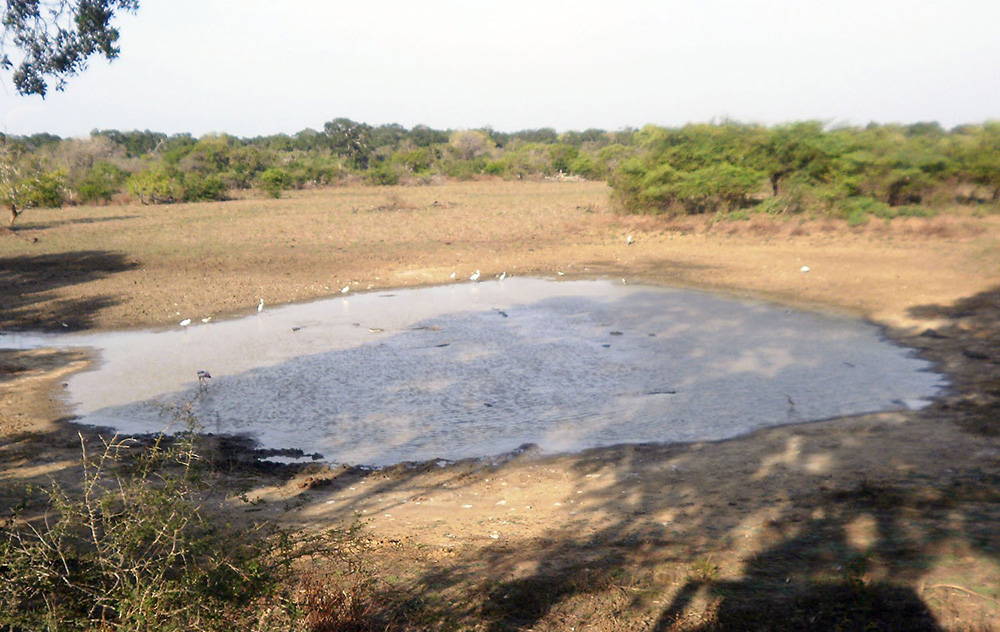
The water came quietly at first, a steady rise along the riverbanks, familiar to communities who have lived beside Sri Lanka’s great waterways for generations. But within hours, these same rivers had swollen into raging, unpredictable forces. The Kelani Ganga overflowed. The Nilwala broke its margins. The Bentara, Kalu, and Mahaweli formed churning, chocolate-brown channels cutting through thousands of homes.
When the floods finally began to recede, villagers emerged to assess the damage, only to be confronted by another challenge: crocodiles. From Panadura’s back lanes to the suburbs of Colombo, and from the lagoons around Kalutara to the paddy fields of the dry zone, reports poured in of crocodiles resting on bunds, climbing over fences, or drifting silently into garden wells.
For many, these encounters were terrifying. But to Sri Lanka’s top herpetologists, the message was clear: this is what happens when climate extremes collide with shrinking habitats.
“Crocodiles are not invading us … we are invading floodplains”
Sri Lanka’s foremost crocodile expert, Dr. Anslem de Silva, Regional Chairman for South Asia and Iran of the IUCN/SSC Crocodile Specialist Group, has been studying crocodiles for over half a century. His warning is blunt.
“When rivers turn into violent torrents, crocodiles simply seek safety,” he says. “They avoid fast-moving water the same way humans do. During floods, they climb onto land or move into calm backwaters. People must understand this behaviour is natural, not aggressive.”
In the past week alone, Saltwater crocodiles have been sighted entering the Wellawatte Canal, drifting into the Panadura estuary, and appearing unexpectedly along Bolgoda Lake.
“Saltwater crocodiles often get washed out to sea during big floods,” Dr. de Silva explains. “Once the current weakens, they re-enter through the nearest lagoon or canal system. With rapid urbanisation along these waterways, these interactions are now far more visible.”
- An adult Salt Water Crocodile (Crocodylus porosus) (Photo -Madura de Silva)
- Adult Mugger (Crocodylus plaustris) Photo -Laxhman Nadaraja
- A Warning sign board
- A Mugger holding a a large Russell ’s viper (Photo- R. M. Gunasinghe)
- Anslem de Silva
- Suranjan Karunarathna
This clash between wildlife instinct and human expansion forms the backdrop of a crisis now unfolding across the island.
A conflict centuries old—now reshaped by climate change
Sri Lanka’s relationship with crocodiles is older than most of its kingdoms. The Cūḷavaṃsa describes armies halted by “flesh-eating crocodiles.” Ancient medical texts explain crocodile bite treatments. Fishermen and farmers around the Nilwala, Walawe, Maduganga, Batticaloa Lagoon, and Kalu Ganga have long accepted kimbula as part of their environment.
But the modern conflict has intensified dramatically.
A comprehensive countrywide survey by Dr. de Silva recorded 150 human–crocodile attacks, with 50 fatal, between 2008 and 2010. Over 52 percent occurred when people were bathing, and 83 percent of victims were men engaged in routine activities—washing, fishing, or walking along shallow margins.
Researchers consistently emphasise: most attacks happen not because crocodiles are unpredictable, but because humans underestimate them.
Yet this year’s flooding has magnified risks in new ways.
“Floods change everything” — Dr. Nimal D. Rathnayake
Herpetologist Dr. Nimal Rathnayake says the recent deluge cannot be understood in isolation.
“Floodwaters temporarily expand the crocodile’s world,” he says. “Areas people consider safe—paddy boundaries, footpaths, canal edges, abandoned land—suddenly become waterways.”
Once the water retreats, displaced crocodiles may end up in surprising places.
“We’ve documented crocodiles stranded in garden wells, drainage channels, unused culverts and even construction pits. These are not animals trying to attack. They are animals trying to survive.”
According to him, the real crisis is not the crocodile—it is the loss of wetlands, the destruction of natural river buffers, and the pollution of river systems.
“When you fill a marsh, block a canal, or replace vegetation with concrete, you force wildlife into narrower corridors. During floods, these become conflict hotspots.”
Past research by the Crocodile Specialist Group shows that more than 300 crocodiles have been killed in retaliation or for meat over the past decade. Such killings spike after major floods, when fear and misunderstanding are highest.
“Not monsters—ecosystem engineers” — Suranjan Karunaratne
On social media, flood-displaced crocodiles often go viral as “rogue beasts.” But conservationist Suranjan Karunaratne, also of the IUCN/SSC Crocodile Specialist Group, says such narratives are misleading.
“Crocodiles are apex predators shaped by millions of years of evolution,” he says. “They are shy, intelligent animals. The problem is predictable human behaviour.”
In countless attack investigations, Karunaratne and colleagues found a repeated pattern: the Three Sames—the same place, the same time, the same activity.
“People use the same bathing spot every single day. Crocodiles watch, learn, and plan. They hunt with extraordinary patience. When an attack occurs, it’s rarely random. It is the culmination of observation.”
He stresses that crocodiles are indispensable to healthy wetlands. They: control destructive catfish populations, recycle nutrients, clean carcasses and diseased fish, maintain biodiversity, create drought refuges through burrows used by amphibians and reptiles.
“Removing crocodiles destroys an entire chain of ecological services. They are not expendable.”
Karunaratne notes that after the civil conflict, Mugger populations in the north rebounded—proof that crocodiles recover when given space, solitude, and habitat.
Floods expose a neglected truth: CEEs save lives—if maintained In high-risk communities, Crocodile Exclusion Enclosures (CEEs) are often the only physical barrier between people and crocodiles. Built along riverbanks or tanks, these enclosures allow families to bathe, wash, and collect water safely.
Yet Dr. de Silva recounts a tragic incident along the Nilwala River where a girl was killed inside a poorly maintained enclosure. A rusted iron panel had created a hole just large enough for a crocodile to enter.
“CEEs are a life-saving intervention,” he says. “But they must be maintained. A neglected enclosure is worse than none at all.”
Despite their proven effectiveness, many CEEs remain abandoned, broken or unused.
Climate change is reshaping crocodile behaviour—and ours
Sri Lanka’s floods are no longer “cycles” as described in folklore. They are increasingly intense, unpredictable and climate-driven. The warming atmosphere delivers heavier rainfall in short bursts. Deforested hillsides and filled wetlands cannot absorb it.
Rivers swell rapidly and empty violently.
Crocodiles respond as they have always done: by moving to calmer water, by climbing onto land, by using drainage channels, by shifting between lagoons and canals, by following the shape of the water.
But human expansion has filled, blocked, or polluted these escape routes.
What once were crocodile flood refuges—marshes, mangroves, oxbow wetlands and abandoned river channels—are now housing schemes, fisheries, roads, and dumpsites.
Garbage, sand mining and invasive species worsen the crisis
The research contained in the uploaded reports paints a grim but accurate picture. Crocodiles are increasingly seen around garbage dumps, where invasive plants and waste accumulate. Polluted water attracts fish, which in turn draw crocodiles.
Excessive sand mining in river mouths and salinity intrusion expose crocodile nesting habitats. In some areas, agricultural chemicals contaminate wetlands beyond their natural capacity to recover.
In Borupana Ela, a short study found 29 Saltwater crocodiles killed in fishing gear within just 37 days.
Such numbers suggest a structural crisis—not a series of accidents.
Unplanned translocations: a dangerous human mistake
For years, local authorities attempted to reduce conflict by capturing crocodiles and releasing them elsewhere. Experts say this was misguided.
“Most Saltwater crocodiles have homing instincts,” explains Karunaratne. “Australian studies show many return to their original site—even if released dozens of kilometres away.”
Over the past decade, at least 26 Saltwater crocodiles have been released into inland freshwater bodies—home to the Mugger crocodile. This disrupts natural distribution, increases competition, and creates new conflict zones.
Living with crocodiles: a national strategy long overdue
All three experts—Dr. de Silva, Dr. Rathnayake and Karunaratne—agree that Sri Lanka urgently needs a coordinated, national-level mitigation plan.
* Protect natural buffers
Replant mangroves, restore riverine forests, enforce river margin laws.
* Maintain CEEs
They must be inspected, repaired and used regularly.
* Public education
Villagers should learn crocodile behaviour just as they learn about monsoons and tides.
* End harmful translocations
Let crocodiles remain in their natural ranges.
* Improve waste management
Dumps attract crocodiles and invasive species.
* Incentivise community monitoring
Trained local volunteers can track sightings and alert authorities early.
* Integrate crocodile safety into disaster management
Flood briefings should include alerts on reptile movement.
“The floods will come again. Our response must change.”
As the island cleans up and rebuilds, the deeper lesson lies beneath the brown floodwaters. Crocodiles are not new to Sri Lanka—but the conditions we are creating are.
Rivers once buffered by mangroves now rush through concrete channels. Tanks once supporting Mugger populations are choked with invasive plants. Wetlands once absorbing floodwaters are now levelled for construction.
Crocodiles move because the water moves. And the water moves differently today.
Dr. Rathnayake puts it simply:”We cannot treat every flooded crocodile as a threat to be eliminated. These animals are displaced, stressed, and trying to survive.”
Dr. de Silva adds:”Saving humans and saving crocodiles are not competing goals. Both depend on understanding behaviour—ours and theirs.”
And in a closing reflection, Suranjan Karunaratne says:”Crocodiles have survived 250 million years, outliving dinosaurs. Whether they survive the next 50 years in Sri Lanka depends entirely on us.”
For now, as the waters recede and the scars of the floods remain, Sri Lanka faces a choice: coexist with the ancient guardians of its waterways, or push them into extinction through fear, misunderstanding and neglect.
By Ifham Nizam
-
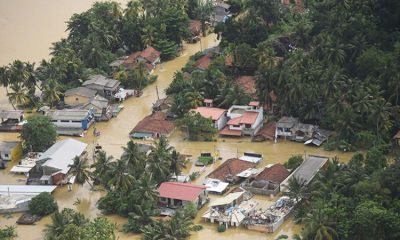
 News6 days ago
News6 days agoWeather disasters: Sri Lanka flooded by policy blunders, weak enforcement and environmental crime – Climate Expert
-
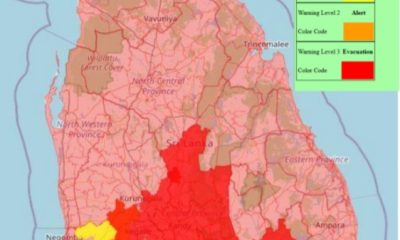
 Latest News7 days ago
Latest News7 days agoLevel I landslide RED warnings issued to the districts of Badulla, Colombo, Gampaha, Kalutara, Kandy, Kegalle, Kurnegala, Natale, Monaragala, Nuwara Eliya and Ratnapura
-

 Latest News7 days ago
Latest News7 days agoINS VIKRANT deploys helicopters for disaster relief operations
-
News3 days ago
Lunuwila tragedy not caused by those videoing Bell 212: SLAF
-
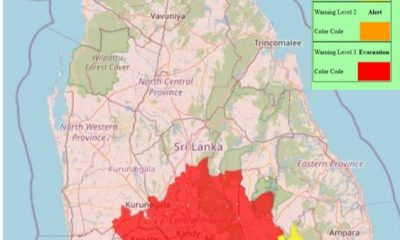
 Latest News4 days ago
Latest News4 days agoLevel III landslide early warnings issued to the districts of Badulla, Kandy, Kegalle, Kurunegala, Matale and Nuwara-Eliya
-
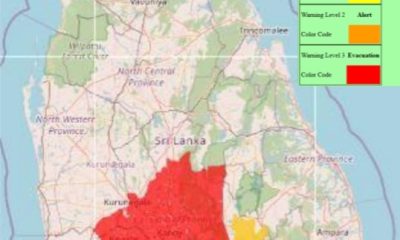
 News2 days ago
News2 days agoLevel III landslide early warning continue to be in force in the districts of Kandy, Kegalle, Kurunegala and Matale
-

 Features4 days ago
Features4 days agoDitwah: An unusual cyclone
-

 Latest News5 days ago
Latest News5 days agoUpdated Payment Instructions for Disaster Relief Contributions


